My August 6th
What I Can Tell You as a Newscaster
Yuki Nakane

August 6th, 78 years after the atomic bombing of Hiroshima.
The older I get, the tougher I become.
To tell you the truth, it took me a while to feel that way.
I intend to cherish this summer as well.
Preface
“Nice to meet you, I’m Yuki Nakane, newscaster at RCC.”
Nine years ago, at the age of 22, after completing what the industry calls my “first chirp,”
I started my career as a newscaster.
My life in Hiroshima began in the spring of 2014.
It was a dream of mine since elementary school to become a newscaster, and I was a little anxious, a little excited…, and full of mysterious expectations for myself (laughs).
Hiroshima, where I was living for the first time, gave the impression of a peaceful city lined with streetcars, home to many flowing rivers, and lush vegetation. During my training period at work, I often took walks around the city whenever I could find time.
I can still vividly remember how, back then, when people asked me, “What is your favorite place in Hiroshima?” I would innocently answer, “Peace Memorial Park!” Thinking back on it now, this answer makes me cringe…”Do you understand enough of what happened there to be able to say that?” I was so immature back then, I want to go back in time and give myself a talking to.
During the nine years I spent in Hiroshima as a newscaster, I worked on RCC Radio’s “Gozensama-sama,” and on RCC TV’s “News 6,” “E-town Sports,” and “Imanama!”. During that time, I reported on many events that have marked the history of Hiroshima, including the 2014 Hiroshima landslides, the 2018 floods in western Japan, the three consecutive championships won by the Hiroshima Carp, the visit of former U.S. President Barack Obama to Hiroshima, and this year’s G7 Summit held in Hiroshima. I truly feel that I have lived through very eventful times as a newscaster in Hiroshima.
Now that I am in my 10th year as a newscaster, I have been given the opportunity to write this essay. It has been nine years since I started working here, coming from outside the prefecture and with very limited knowledge. However, now that I have gained a little experience, I would like to write about how my heart was transformed during those nine years (although it scares me a little bit). I hope you will read until the end.
My First Experience of August 6th
I had watched the Peace Memorial Ceremony several times on TV when I was a student. That said, I had only seen a portion of the ceremony, which was shown on the national news.
I had never witnessed the entire ceremony in real time. In 2014, when I was first hired, as part of my training, I was allowed to wear a “PRESS” pass and enter the Peace Memorial Park where the ceremony was to take place. The ceremony was held in unusually rainy weather that year. The actual event was quite different from what I had envisioned from watching it on TV. The music, the number of visitors, the smell of incense, and everything else about it was fresh and new. What was even more surprising was that as I walked around the Peace Memorial Park after the ceremony, there were people everywhere, performing live music, holding art exhibitions, making speeches, and marching in demonstrations.
Reporting About August 6th in the News
It was my first year on the job. I was assigned to the news program “News 6” with no idea what I was doing. In my second year, I became one of the main newscasters. It was a terrifying but very gratifying experience. However, in those days, I was filled with anxiety, because being born and raised in Fukuoka Prefecture, unfortunately, I had never received what is called “peace education”. Talking with my father and mother, they said that when they were growing up, August 6th was a regular school day and they used to also have peace education, but for my generation, August 6th wasn’t even a school day anymore.
As a result, time spent learning about the atomic bombing was extremely limited. Every year, as summer approaches in Hiroshima, there is always something related to the atomic bombing or peace in the news… and as newscasters we are expected to comment on the news at the end…
“How can I possibly comment on this topic?…”
Every day I would read the script in advance, consult with the person in charge of the story, and somehow manage to squeeze out a few remarks by racking my brains. I was fed up with my lack of knowledge and my lack of skills in presenting, feeling that no matter what I said, it didn’t feel right, talking pretty words with no substance. I gradually became unable to discuss “peace,” and began to avoid it altogether.
A significant event happened in 2019 that changed this negative attitude.
My Grandmother Born in Hiroshima
My grandmother is from Hiroshima Prefecture. I always buy her Hiroshima momiji manju before I go visit my hometown in Fukuoka Prefecture. My grandmother’s favorites are those with sweet red bean paste filling.
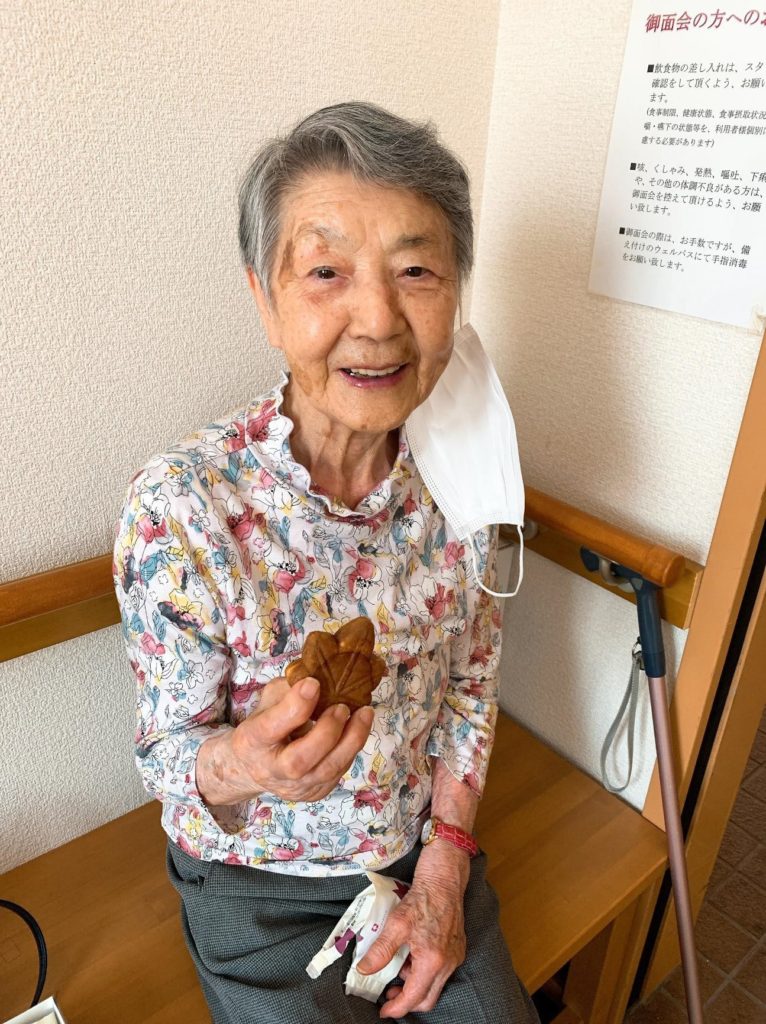
“The grains in the red bean paste have a nice texture. It’s delicious.”
She loved them since childhood, and always gobbles them up happily.
My grandmother moved to Fukuoka Prefecture at the age of 30 when she got married, where my mother was born and I was born. Now 95 years old, she is still very much alive and well in Fukuoka. When I was in junior high school, I visited Hiroshima with my grandmother, mother, and younger sister. According to my mother, she wished that we girls could hear her story of the atomic bombing, even if only once. We went to see my grandmother’s relatives and to visit the Hiroshima Peace Memorial Museum together. My grandmother told me many stories in front of the exhibits lined up in the museum, but unfortunately, I don’t remember most of them.
15 Years Later.
As I realized my dream and gained experience as a newscaster, I began wishing that I had a chance to properly listen to my grandmother’s experience of the atomic bombing. Because her relatives still live in Hiroshima, until a few years ago my grandmother would come to Hiroshima by herself on the bullet train whenever there was a memorial service or other occasions. Whenever she did, we always went to eat okonomiyaki together, and it became a tradition for us to eat a whole plate of niku tama soba (lit: “meat”, “egg” and “noodle”, a typical Hiroshima-style okonomiyaki primarily cooked with layers of batter, cabbage, bean sprouts, noodles and pork.) On one such occasion, she told me, “I recently wrote a memoir about my experience of the atomic bombing, to mark the end of my life.” “You should read it, too, Yuki,” she said. Not having been born and raised in Hiroshima Prefecture and not having received adequate peace education, I asked myself, “Am I qualified to tell this story? What can I say?” as I reported the news about Hiroshima.
I couldn’t help but get goosebumps and cry as I read about my grandmother’s heroic story, written down on six sheets of manuscript paper.
Now I would like to share with you the memories my grandmother shared with me.
My Grandmother’s Memories of the War
In 1945, my grandmother was a first-year student at the Hiroshima Jogakuin Vocational School. At that time, female students had been mobilized to work in plants and factories. The entrance ceremony, which had been postponed, was finally scheduled for August 6th, which happened to be a school day.
My grandmother’s mother had bought her new shoes, for she was going to school for the first time in a long time. My grandmother was looking forward to putting on her shiny new shoes and meeting her friends as she headed off to school. On her way to school, the air raid alarm sounded once causing her to evacuate to a nearby air-raid shelter, however, everything was fine, so she went straight to school.
And then came 8:15 a.m., while the piano sounded of hymns in the school’s chapel.
And then there was a big flash of light! When she came to, she realized that she was buried under rubble! The whole place was in darkness. She couldn’t see anything but she recalls that “I heard a voice saying ‘It’s open here!’, and you know, I was really tiny, so I climbed out through the rubble”.
My grandmother miraculously survived among the rubble. However, because she had taken off her shoes before entering the chapel, her precious new shoes were lost in the rubble… My grandmother had to walk barefoot through the burnt ruins of Hiroshima. Her goal was to reach Ushitayama, where the school had been evacuated to. On the way there, she met a survivor who asked for water, so she scooped him some water from a pond and offered it to him to drink. By the time she finally got to her destination, she was starving. Her story also tells of the green tomatoes she found there.
“Back then, I hated tomatoes. But there were only tomatoes there. All I had was a single green tomato. So I ate it, saying ‘it’s so good, it’s so good.’”
During the war, the family had decided to meet at the temple in Hachihonmatsu “in case something bad happened.”
After a restless night in Ushitayama, she walked down the mountain and reached Kaita Station. The place was packed with people. My grandmother, who was very tiny, was lucky to be put in a freight car that took her down to Hachihonmatsu Station where she got off and headed for the temple where her family was to meet. There, my grandmother was able to reunite with her two older sisters and her mother. However, her steadfast eldest sister and her adored younger brother, who was in junior high school, never made it there. The next day, the family set out together to look for them in the city. They headed for Ninoshima, where they heard that there were injured people being brought in. She walked silently with her mother and sisters through the burnt fields of Koi and other places that had been turned into aid stations, under the blazing summer sun. Unfortunately, her eldest sister was killed by the blast while she was working at a clothing depot, and her younger brother was killed while helping to evacuate a building.
“We didn’t even have their remains to bury. We realized there was nothing we could do, and made our way home.”
Two years later, her mother, whom she loved so much and who had given her the new pair of shoes, died from radiation sickness caused by the atomic bomb.
I could suddenly put a face to the tragedy of the atomic bombing, which I had only learned about in textbooks until then… That’s how I felt. Even now, the horror still brings tears to my eyes when I try to picture it, “I wonder if my grandmother was one of the people who gave water to the many burn victims out there in the scorched ruins of the city.
Then something in me changed drastically.
Perhaps it was at this time that I finally came face to face with Hiroshima.
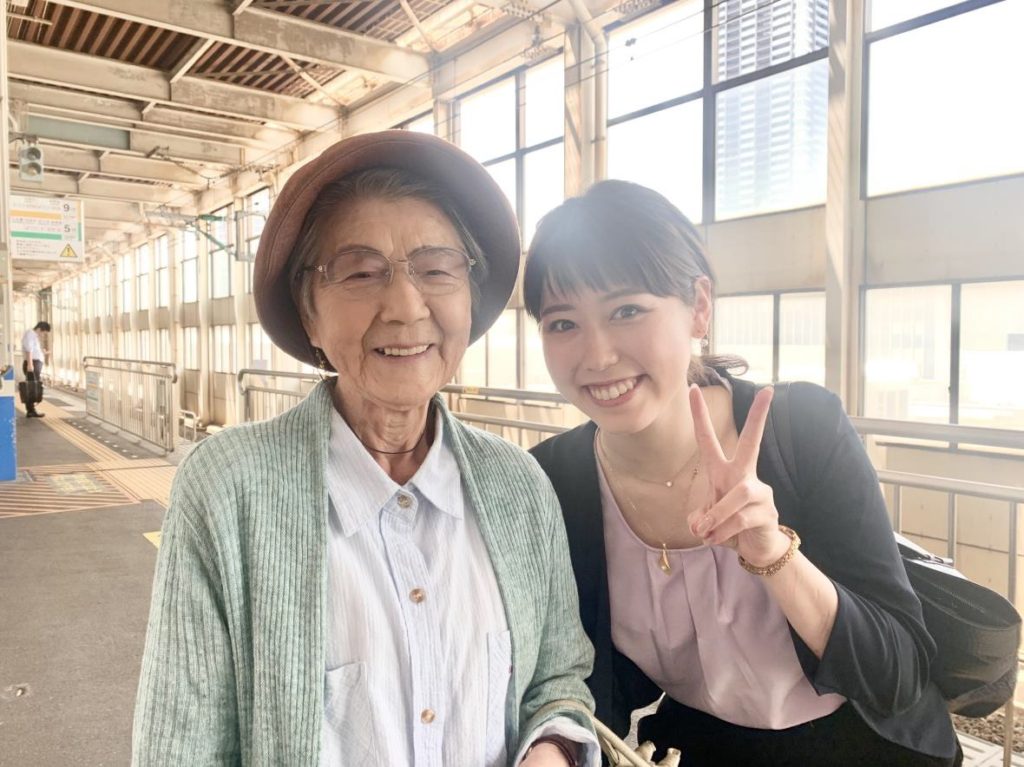
One of the things that struck me about my grandmother’s story is that she describes it as “her experience of the atomic bombing.”
She has, of course, many tragic and sad memories of losing family members and friends. But she also recalls how happy she was when she got her shiny new shoes, how she cherished and enjoyed eating momiji manju, and how she came to like tomatoes, which she had hated until that moment. She also had memories of being a 17-year-old girl living under wartime conditions.
My grandmother’s story was aired in the summer of 2019 in a special one-hour program called “From Grandma to Me”. The special was broadcast nationwide, and we were very surprised by the response we received, including letters that came from other prefectures.
The only reason you can hear my voice today is because she survived and lived. I am so grateful to my grandmother, the woman through whom I was brought into this world. What I really hope to do as an announcer working in Hiroshima is to convey the sanctity of peace to the public.
Reflecting on Peace through Interviews
It was as if I had been entrusted by my grandmother with something, for I had received her thoughts and feelings. I began to think about the meaning of being a newscaster in Hiroshima, my grandmother’s hometown, although I was born and raised in Fukuoka. Then, last year, as I began to think that I wanted to be actively involved in reporting on “peace,” I had a fateful encounter.
The owner of an okonomiyaki restaurant I happened to walk into told me that he was going to teach okonomiyaki in Jordan, in the Middle East.
“What? In Jordan?!” I said.
This was the beginning of my very first project coverage.
A peace cultural exchange between Hiroshima in Jordan in the Middle East through okonomiyaki, the soul food of Hiroshima.
On the heels of okonomiyaki, I also headed to Jordan to cover the event.
The impetus for the project came from the Jordanian Ambassador to Japan, who expressed a strong desire to “share the taste and history of Hiroshima’s okonomiyaki with Jordan and the Middle East.”
The Hashemite Kingdom of Jordan is surrounded by countries that were in conflict at the time, including Iraq, Syria, and Israel, and continues to host many refugees to this day. As I interviewed people in a Palestinian refugee camp, I met a family that had been living in the camp for four generations. I also found out for the first time that many of the refugees are born inside the camps now. I asked a third-generation refugee, “Where do you call home?”.
He answered in a determined tone, “My homeland is Palestine , and that will never change.”
The people of Palestine, who were forced to leave their homeland due to the war and whose territory has been almost wiped off the map, still live in the belief that “one day we will return to our homeland,” even after more than 70 years.
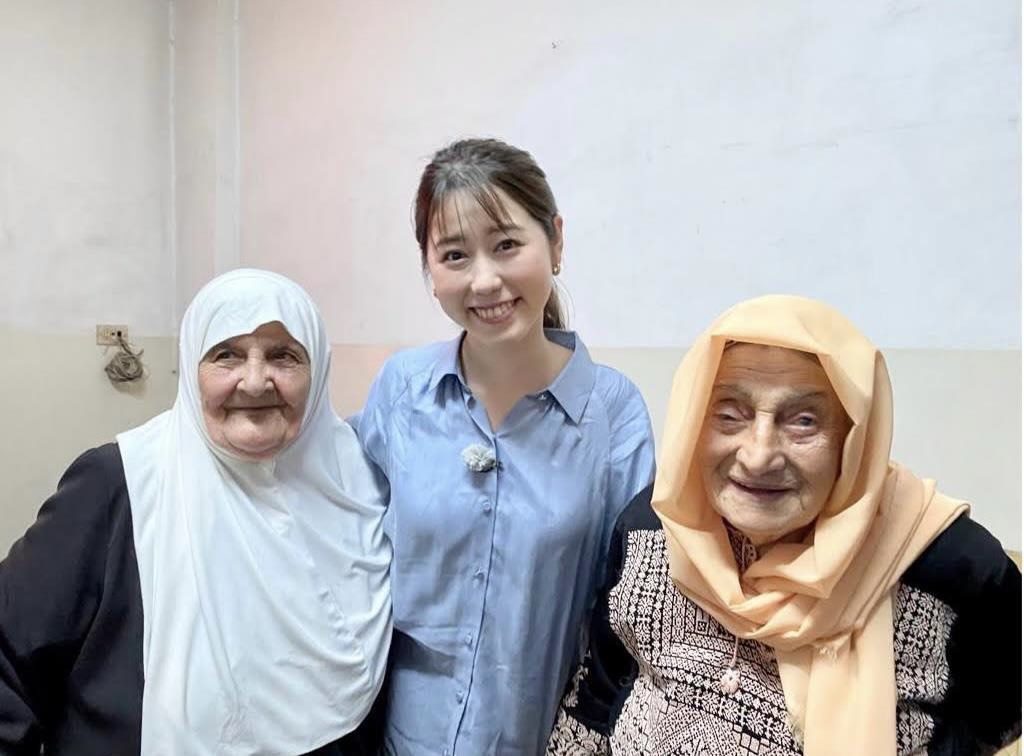
The Jordanian Ambassador to Japan proposed this project in the hope that it would “encourage people to think about peace,” by juxtaposing the history of the recovery of the A-bombed city of Hiroshima, where it was said that not even a blade of grass would grow, with the culinary culture of okonomiyaki, which developed from issen yoshoku (lit: one-penny Western food) (You can find a thorough explanation of what “issen yoshoku” is by visiting this page: Okonomiyaki: the food that helped rebuild Hiroshima)
While in Jordan, we followed a restaurant owner who served okonomiyaki to the locals and also taught the history of Hiroshima as well as how to make okonomiyaki at a culinary school.

As the atomic bomb survivors get older and we face an enormous challenge as to how to pass on the history of the atomic bombing, we want to encourage people not only in Japan but also abroad to think about the history of Hiroshima and about peace. I felt that this could be a new way to pass on peace to the next generation.
President Zelensky of Ukraine came to Hiroshima for the G7 Summit. One theme that I have been covering with great passion recently is that of the Ukrainian sisters who have been forced to flee their homeland. They are two sisters who have been evacuated from Ukraine. Fazilya (the older sister) and Maria (the younger sister). The sisters are very close and very charming.
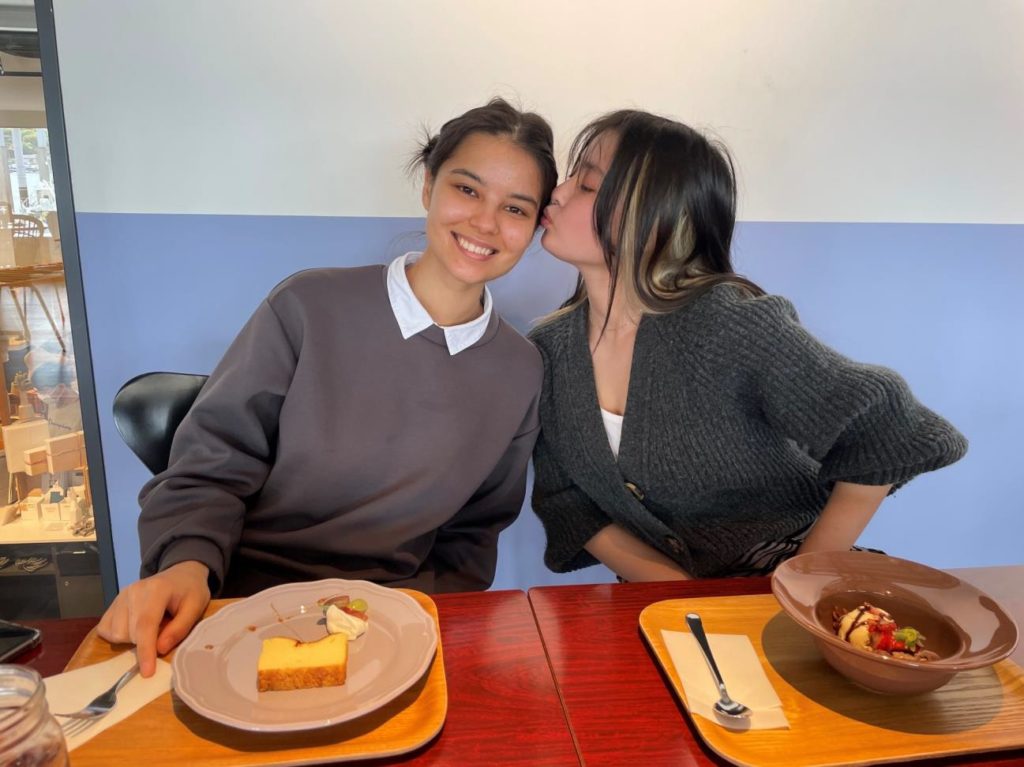
They came to Hiroshima last September, when the Russian invasion of Ukraine began. I asked them about the day the war began.
“One morning I woke up and all of a sudden there was a war going on. I couldn’t believe that in this day and age, war was happening. I couldn’t believe it. I asked my mother, ‘What should I do about school? She said, ‘You don’t have to go to school.'”
From that day on, their lives were completely transformed.
All of a sudden, everyday life was snatched away from them.
They said that they could actually hear the sound of missiles destroying buildings. At home, they were told to stay at least one room away from the outer wall to protect themselves against the missile attack, so they spread bedding in the bathtub and slept there for a while.
Thus, the sisters were evacuated from war-ravaged Ukraine, where they were now forced to live like that, to the safety of Hiroshima. However, they are filled with anxiety about the safety of their family and friends, with anger and sadness at having their daily lives taken away from them, and with uncertainty about what their future holds. Their hearts are never at ease. When I was interviewing these women, I felt a deep sense of outrage at how war comes to engulf ordinary, innocent people.
The sisters are now working for a company in Hiroshima, cooking Ukrainian cuisine with Japanese ingredients from the supermarket, and trying to make friends at the gym, all the while longing to return to their hometown as soon as possible. They are also working hard to adjust to life in Hiroshima.
A few weeks ago, the sisters’ mother arrived in Japan from Ukraine, giving them a bit of a comforting reunion after a year apart.
Waiting at the airport arrival gate, the two of them jumped up the moment they spotted their mother, and as soon as they reached her, they were in each other’s arms. The sight of them hugging each other tightly with tears streaming down their faces was heart-wrenching.
For the past year, the two sisters had struggled alone in a foreign land. I was very moved by the relief on their faces when they were reunited with their mother and became “daughters” again.
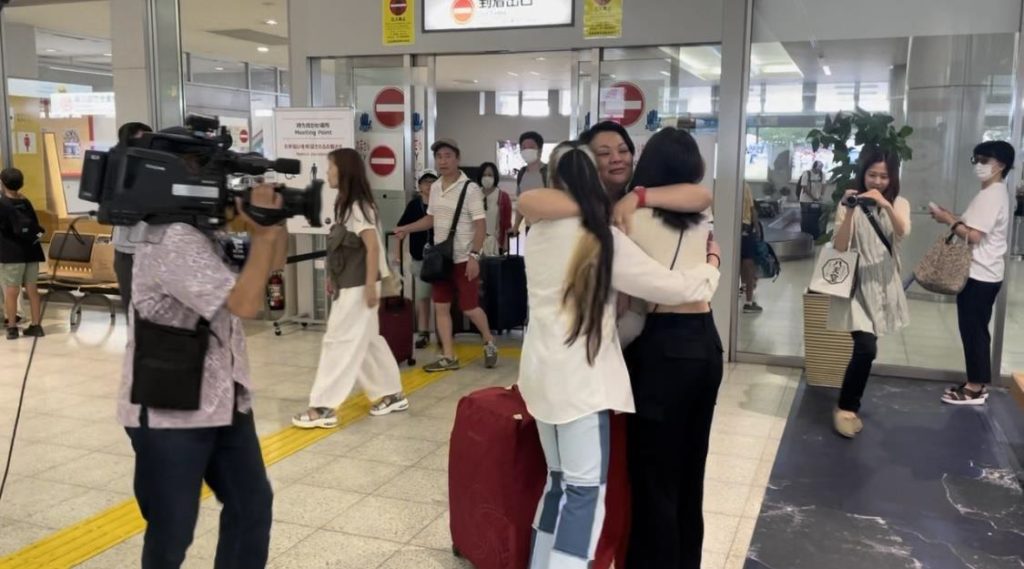
I hope to be a newscaster who can convey these thoughts and feelings to the audience.
August 6th, the 10th Time I Came to Hiroshima.
The sound of cicadas fill the air, and it looks like we will have another hot August 6th this year.
In recent years, an increasing number of second and third generation atomic bomb survivors have been visiting Peace Memorial Park on behalf of their grandparents and parents who have passed on, as well as those who were unable to visit the park due to their advanced age. I feel that the yearning for peace has definitely been passed down from generation to generation, which is reflected in the pure atmosphere that pervades Peace Memorial Park on August 6th.
This year, the COVID-19 outbreak has calmed down a bit, and we are finally seeing the return of the usual ceremonies.
There are people performing live music, holding art exhibitions, making speeches, and marching in demonstrations. I will be sharing your thoughts on peace so that they can reach the world.
Peace Memorial Park is still my favorite place to take a walk.
It is a place where all kinds of people come to relax, including tourists from all over the world, runners, couples taking a break on the benches, and people listening to the Carp games on the radio.
When I pass by the cenotaph, I think of all that happened there. And although I have never met them, I keep my grandmother’s family updated on what is going on.
This is a park where many thoughts and feelings converge.
If someone were to ask me, “What is your favorite place in Hiroshima?” I think I would still answer, Peace Memorial Park.”
Carrying in my heart the experience of the atomic bombing as told to me by my grandmother, and cherishing the thoughts of the many people I have met while covering these events, I want to continue to be a force for good in my role as a newscaster in Hiroshima.
Thank you for reading this far.
Profile
Yuki Nakane
Born in 1991 in Fukuoka, Japan, she joined RCC Chugoku Broadcasting in 2014.
TV “Imanama! (Wednesday, Thursday, Friday main MC), “Golf Zammai”. Radio “Heisei Radio Variety Gozensama-sama” (Wednesday personality). She received the 2019 JNN Anoncisto Award for Excellence in Narration for her special program, “From Grandma to Me.”
Tags associated with this article



③食卓囲む-150x150.jpg)
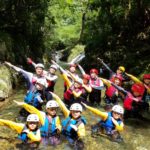
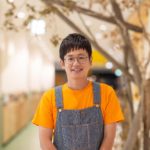
![[1:55 PM JST (UTC+9), Saturday August 6] Live streaming of a dialogue event in Hiroshima between UN Secretary-General Mr. António Guterres and youth activists [1:55 PM JST (UTC+9), Saturday August 6] Live streaming of a dialogue event in Hiroshima between UN Secretary-General Mr. António Guterres and youth activists](https://hiroshimaforpeace.com/en/wp-content/uploads/sites/2/2019/07/P00411-2-150x150.jpg)

